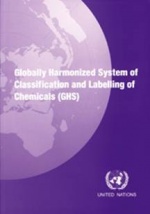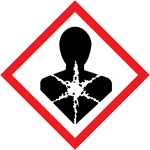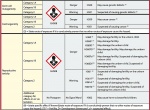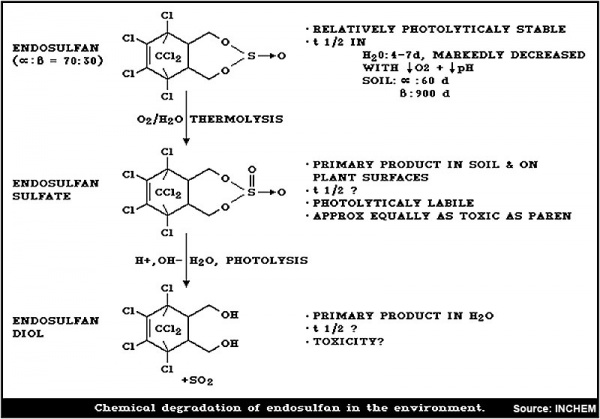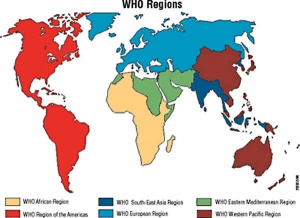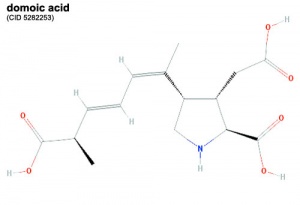Abnormal Development - Chemicals
| Embryology - 25 Apr 2024 |
|---|
| Google Translate - select your language from the list shown below (this will open a new external page) |
|
العربية | català | 中文 | 中國傳統的 | français | Deutsche | עִברִית | हिंदी | bahasa Indonesia | italiano | 日本語 | 한국어 | မြန်မာ | Pilipino | Polskie | português | ਪੰਜਾਬੀ ਦੇ | Română | русский | Español | Swahili | Svensk | ไทย | Türkçe | اردو | ייִדיש | Tiếng Việt These external translations are automated and may not be accurate. (More? About Translations) |
Introduction
Effects due to environmental chemicals on development, both pre- and post-natal are difficult to quantify. There are also chemical hazards to development covered elsewhere in these notes, Metals, Fetal Alcohol Syndrome, smoking, illicit drugs. Postnatally some chemicals can be also transferred through milk or contamination of milk formulas. Several environmental chemicals, or their products, have been identified as endocrine disruptors.
The specific effects of chemicals is detailed in chemical Safety and Data Sheets (SDS). These sheets are now generally required to be supplied along with the chemical purchased from a supplier and give a standardised description of the chemical, its physical properties, handling and health effects/toxicity. The information relating to chemical safety is continuously changing and the most current source of Safety Data Sheet (SDS) should be used for accurate information. Note the original term for this associated information sheet was a Material Safety Data Sheet (MSDS). There are also several internet sites that have searchable databases of SDS information. Note that handling chemical safety has previously varied from country to country.
Recently the WHO has developed an internationally agreed-upon system Globally Harmonized System of Classification and Labeling of Chemicals (GHS) that will eventually standardise this information.
In addition, there is much information about chemicals in relation to food safety and poisoning.
Some Recent Findings
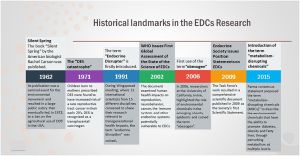
|
| More recent papers |
|---|
|
This table allows an automated computer search of the external PubMed database using the listed "Search term" text link.
More? References | Discussion Page | Journal Searches | 2019 References | 2020 References Search term: Chemical Teratology <pubmed limit=5>Heavy Metal Teratology</pubmed> Search term: Persistent Organic Pollutant Teratology <pubmed limit=5>Persistent Organic Pollutant Teratology</pubmed> |
| Older papers |
|---|
|
United Nations - Globally Harmonized System of Classification and Labelling of Chemicals
(GHS) The new system, which was called "Globally Harmonized System of Classification and Labelling of Chemicals (GHS)", addresses classification of chemicals by types of hazard and proposes harmonized hazard communication elements, including labels and safety data sheets. It aims at ensuring that information on physical hazards and toxicity from chemicals be available in order to enhance the protection of human health and the environment during the handling, transport and use of these chemicals. The GHS also provides a basis for harmonization of rules and regulations on chemicals at national, regional and worldwide level, an important factor also for trade facilitation.
(Text from UN Website)
GHS08 Health Hazard
Of the 9 pictogram codes, this relates to systemic health hazard as well as reproductive and developmental effects.
Germ cell mutagenicity (State route of exposure if it is conclusively proven that no other routes of exposure cause the hazard)
- Category 1A - Danger - H340 - May cause genetic defects
- Category 1B - Danger - H340 - May cause genetic defects
- Category 2 - Warning - H341 - Suspected of causing genetic defects
Carcinogenicity (State route of exposure if it is conclusively proven that no other routes of exposure cause the hazard)
- Category 1A - Danger - H350 - May cause cancer
- Category 1B - Danger - H350 - May cause cancer
- Category 2 - Warning - H351 - Suspected of causing cancer
Reproductive toxicity (state specific effect if known)(state route of exposure if it is conclusively proven that no other routes of exposure cause the hazard)
- Category 1A - Danger
- H360 - May damage fertility or the unborn child.
- H360F - May damage fertility.
- H360D - May damage the unborn child.
- H360FD - May damage fertility. May damage the unborn child.
- Category 1B - Danger
- H360Fd - May damage fertility. Suspected of causing damage the unborn child.
- H360Df - May damage the unborn child. Suspected of damaging fertility.
- Category 2 - Warning
- H361 - Suspected of damaging fertility or the unborn child.
- H361f - Suspected of damaging fertility.
- H361d - Suspected of damaging the unborn child.
- H361fd - Suspected of damaging fertility. Suspected of damaging the unborn child.
- Additional category for effects on or via lactation (no pictogram)
- H362 - May cause harm to breast-fed children.
Chemical Terms
Below are listed some terms which relate to a chemicals harmful effects.
Acute Toxicity
Adverse effects occurring following oral or dermal administration of a single dose of a substance, or multiple doses given within 24 hours, or an inhalation exposure of 4 hours. This is further classified by five toxicity categories based upon exposure route.
Carcinogen
A chemical known or believed to cause cancer in humans. The number of known carcinogens is comparatively small, but many more chemicals are suspected to be carcinogenic.
Effective Dose
(ED50) The amount of material required to produce a specified effect in 50% of an animal population. (See qualification in the definition of LD50).
Lethal Dose
(LD50) The dose of a chemical which kills 50% of a sample population. In full reporting, the dose, treatment and observation period should be given. Further, LD50 and ED50 values are strictly only comparable when the age, sex and nutritional state of the animals is specified. Nevertheless, LD50 values are widely reported as a measure of the potential toxicity of chemicals.
Material Safety Data Sheet
(MSDS) A defined set of information about a specific chemical's properties, risks, hazards and toxicity. This term in Australia is being replaced by Safety Data Sheet (SDS), under the United Nations Globally Harmonized System of Classification and Labelling of Chemicals (GHS) program to standardise chemical data around the world.
Mutagen
An agent that changes the hereditary genetic material which is a part of every living cell. Such a mutation is probably an early step in the sequence of events that ultimately leads to the development of cancer.
Reproductive Toxicity
Adverse effects on sexual function and fertility in adult males and females, as well as developmental toxicity in the offspring.
Risk
The probability that a hazard will give rise to an adverse effect at a level in a specified period and is normally indicated in descriptive terms; high, modest, negligible. A hazard is the potential for physical harm to life, health or property.
Safety Data Sheet
(SDS) Under the United Nations "Globally Harmonized System of Classification and Labelling of Chemicals" (GHS) program to standardise chemical data around the world.
Solvents
Are liquids which can dissolve substances. Organic solvents (examples) are also used in paints and adhesives and include aromatic solvents (xylene and toluene), aliphatic hydrocarbons (kerosene and n-heptane), alcohols (ethanol and isopropanol), glycols (ethylene glycol), esters (iso-propyl acetate), chlorohydrocarbons (methylene chloride), ethers (diethylene glycol), ketones and aldehydes (acetone).
Threshold Limit Value
(TLV) The maximum permissible concentration of a material, generally expressed in parts per million in air for some defined period of time (often 8 hours). These values, which may differ from country to country, are often backed up by regulation and are therefore often legally enforceable.
Persistent Organic Pollutants
(POPs) These are organic (carbon-based) chemical substances with a combination of physical and chemical properties that once released into the environment:
- remain intact for exceptionally long periods of time (many years)
- become widely distributed throughout the environment as a result of natural processes involving soil, water and, most notably, air
- accumulate in the fatty tissue of living organisms including humans, and are found at higher concentrations at higher levels in the food chain
- are toxic to both humans and wildlife
Stockholm Convention on Persistent Organic Pollutants
The Stockholm Convention on Persistent Organic Pollutants is a global treaty to protect human health and the environment from chemicals that remain intact in the environment for long periods, become widely distributed geographically, accumulate in the fatty tissue of humans and wildlife, and have adverse effects to human health or to the environment. The text of the Stockholm Convention on Persistent Organic Pollutants was adopted 22 May 2001 and entered into force ninety days after the deposit of the fiftieth instrument of ratification, acceptance, approval or accession by a country to the Convention, 17 May 2004.
Twelve persistent organic pollutants were initially recognized as causing adverse effects on humans and the ecosystem. These have been placed in 3 categories.
- Pesticides: aldrin, chlordane, DDT, dieldrin, endrin, heptachlor, hexachlorobenzene, mirex, toxaphene;
- Industrial chemicals: hexachlorobenzene, polychlorinated biphenyls (PCBs); and
- By-products: hexachlorobenzene; polychlorinated dibenzo-p-dioxins and polychlorinated dibenzofurans (PCDD/PCDF), and PCBs.
Annex A (Elimination)
Parties must take measures to eliminate the production and use of the chemicals listed under Annex A. Specific exemptions for use or production are listed in the Annex and apply only to Parties that register for them.
Aldrin, Chlordane, Chlordecone, Dieldrin, Endrin, Heptachlor, Hexabromobiphenyl, Hexabromodiphenyl ether and heptabromodiphenyl ether, Hexachlorobenzene (HCB), Alpha hexachlorocyclohexane, Beta hexachlorocyclohexane, Lindane, Mirex, Pentachlorobenzene, Polychlorinated biphenyls (PCB), Tetrabromodiphenyl ether and pentabromodiphenyl ether, Toxaphene
Annex B (Restriction)
Parties must take measures to restrict the production and use of the chemicals listed under Annex B in light of any applicable acceptable purposes and/or specific exemptions listed in the Annex.
DDT, Perfluorooctane sulfonic acid, its salts and perfluorooctane sulfonyl fluoride
Annex C (Unintentional production)
Parties must take measures to reduce the unintentional releases of chemicals listed under Annex C with the goal of continuing minimization and, where feasible, ultimate elimination.
Polychlorinated dibenzo-p-dioxins (PCDD), Polychlorinated dibenzofurans (PCDF), Hexachlorobenzene (HCB), Pentachlorobenzene, Polychlorinated biphenyls (PCB)
Polychlorinated Biphenyls
A recent study using rat model showed effects on fetal cerebral cortex development through radial neuronal migration in the fetal cortex.[13]
An example of the effects of polychlorinated biphenyls (PCBs) can be seen following contaminated rice oil consumption in Taiwan between 1978-1979.[17][18]
- "Yucheng "oil-disease" victims were Taiwanese people exposed to polychlorinated biphenyls (PCBs) and their heat-degradation products, mainly polychlorinated dibenzofurans (PCDFs), from the ingestion of contaminated rice oil in 1978-1979. Serial studies in Yucheng offspring born between 1978 and 1992 are summarized. Children of the exposed women were born with retarded growth, with dysmorphic physical findings, and, during development, with delayed cognitive development, increased otitis media, and more behavioral problems than unexposed children. Recently, examination of the reproductive system has suggested that prenatal exposure exerts late effects on semen parameters in young men after puberty. Results of the investigation in Yucheng children will provide important information about the human health effects and toxicology of PCB/PCDF exposure. Prenatal exposure to these environmental chemicals causes the fetus to be sensitive to the toxic effects of persistent organic pollutants." [17]
| Groups of chemicals | Level of Acton | 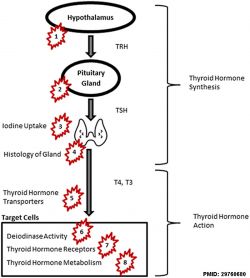
|
|---|---|---|
| polychlorinated biphenyl (PCB) and polychlorinated dibenzodioxins (PCDD) | 5, 7 | |
| polybrominated diphenyl ethers (PBDEs) | 5, 6, 7, 8 | |
| pesticides | 4, 5, 7 | |
| perfluoroalkyl substances (PFASs) | 5, 6; NIS: 3 | |
| bisphenol A (BPA) | 2, 7 | |
| phthalates | 1, 2, 5, 8. | |
| Table Data[19] Links: thyroid | chemicals | endocrine abnormalities | ||
- Links: endocrine abnormalities
Endosulfan
Endosulfan is commercial name for a chemical (6,7,8,9,10,10-hexachloro-1,5,5a,6,9,9a-hexahydro- 6,9-methano-2,4,3-benzodioxathiepin-3-oxide) broad-spectrum insecticide and acaricide to control agricultural insect and mite pests in crops. Technical-grade endosulfan is composed of two stereochemical isomers, alpha-endosulfan (70%) and beta-endosulfan (30%), at high levels chemical has acute toxicity and neurological effects.
Endosulfan environmental breakdown
An Indian study has suggested that it acts as an endocrine disruptor, exposure in male children may delay sexual maturity and interfere with sex hormone synthesis.[20] There has been some criticism of the data used in this particular study.[21][22]
Dioxin 20XX
Dioxin 20XX is a non-profit organization founded by the International Advisory Board of the International Symposium on Halogenated Persistent Organic Pollutants (POPs) for the purpose of promoting scientific education and research on POPs. Dioxin20XX facilitates the organization of the annual International "Dioxin" Symposium and publishes "Organohalogen Compounds".
Styrene
In 2008 as part of the US National Toxicology Program a report "Final Report on Carcinogens Background Document for Styrene"[23] looking into the potential carcinogenic effects of styrene. The following text has been modified from that report.
Styrene Properties - viscous, highly flammable liquid used worldwide in the production of polymers.
Styrene Uses - incorporated into many products in our environment (rubber, plastic, insulation, fiberglass, pipes, automobile parts, food containers, and carpet backing).
Absorption - absorbed through inhalation, ingestion, or skin contact. Most important route of exposure in humans in occupational settings is by inhalation, which results in rapid absorption
Distribution - highest tissue concentrations (60% to 70%) of inhaled styrene are in subcutaneous fat.
Formaldehyde
In 2010 as part of the US National Toxicology Program a report "Final Report on Carcinogens Background Document for Formaldehyde"[24] looking into the potential carcinogenic effects of formaldehyde.
Carbon Monoxide
(CO) A colourless and odorless gas formed mainly as a by-product of incomplete combustion of hydrocarbons and can cause cytotoxicity by tissue hypoxia. Smoking tobacco is also a source of carbon monoxide. A recent study has identified in a newborn mouse model, effects on neurodevelopment of even sub-clinical levels of carbon monoxide.[25]
Carbon monoxide:
- enters circulation though the respiratory system
- binding to haemoglobin to form carboxy-haemoglobin (COHb)
- haemoglobin affinity is 240 times greater than for oxygen
- fetal haemoglobin binds with even greater affinity
- tissue hypoxia occurs when COHb levels are greater than 70%
- Links: Smoking - Carbon Monoxide
USA - National Toxicology Program
The following information is an excerpt from the website background information (February 17, 2005).
- The NTP is an interagency program whose mission is to evaluate agents of public health concern by developing and applying tools of modern toxicology and molecular biology. The program maintains an objective, science-based approach in dealing with critical issues in toxicology and is committed to using the best science available to prioritize, design, conduct, and interpret its studies. To that end, the NTP is continually evolving to remain at the cutting edge of scientific research and to develop and apply new technologies.
- More than 80,000 chemicals are registered for use in the United States. Each year, an estimated 2,000 new ones are introduced for use in such everyday items as foods, personal care products, prescription drugs, household cleaners, and lawn care products. We do not know the effects of many of these chemicals on our health, yet we may be exposed to them while manufacturing, distributing, using, and disposing of them or when they become pollutants in our air, water, or soil. Relatively few chemicals are thought to pose a significant risk to human health. However, safeguarding public health depends on identifying both what the effects of these chemicals are and at what levels of exposure they may become hazardous to humans—that is, understanding their toxicology.
Center for the Evaluation of Risks to Human Reproduction
The National Toxicology Program (NTP) Center for the Evaluation of Risks to Human Reproduction (CERHR) was established in 1998 to serve as an environmental health resource to the public and regulatory and health agencies. CERHR publishes monographs that assess the evidence that environmental chemicals, physical substances, or mixtures (collectively referred to as "substances") cause adverse effects on reproduction and development and provide opinion on whether these substances are hazardous for humans.
Australia
Therapeutic Goods Administration
Standard for the Uniform Scheduling of Drugs and Poisons (SUSDP) - produced by the National Health and Medical Research Council (NHMRC) is the basis for State and Territory Poisons Act legislation (which may differ between regions in detail). The legislation applies restrictions at the point of sale. There are nine Poisons Schedules listing substances or types of substances which require certain labelling and description, packaging (inner and outer), controls on advertising and supply, storage, and for some, the permitted level of impurities.
Revised medicines and chemicals scheduling arrangements (23 Nov 2010)
- the National Drugs and Poisons Schedule Committee (NDPSC) will be replaced by the Secretary of the Department of Health and Ageing (DoHA) - or her delegate - as the decision maker for the scheduling of medicines and chemicals.
- two new expert advisory committees, the Advisory Committee on Medicines Scheduling and the Advisory Committee on Chemicals Scheduling, will be established to provide advice and make recommendations to the Secretary (or delegate) on medicines and chemicals scheduling decisions.
- a single Secretariat, supporting both Advisory Committees, will ensure ongoing consistency and cohesiveness of processes and decisions.
- closer integration of the revised scheduling arrangements with existing Commonwealth evaluation and product registration schemes.
- Links: Poisons Standard 2010 | TGA - About The Poisons Standard | Therapeutic Goods Administration | Revised Scheduling Nov 2010
Safe Work Australia
An independent statutory agency responsible to improve occupational health and safety and workers' compensation arrangements across Australia.
- Links: [Work Australia | Hazardous Substances Information System | PDF - Approved Criteria for Classifying Hazardous Substances [NOHSC: 1008 (2004)
Food Standards Australia
This government body's responsibility is to develop and administer the Australia New Zealand Food Standards Code (the Code), which lists requirements for foods such as additives, food safety, labelling and GM foods. Enforcement and interpretation of the Code is the responsibility of State/Territory departments and food agencies within Australia and New Zealand.
National Measurement Institute
National Measurement Institute (NMI) is Australia's peak measurement body responsible for biological, chemical, legal, physical and trade measurement.
National Research Centre for Environmental Toxicology (Queensland)
(EnTox) This centre is a Joint Venture of the University of Queensland and the Queensland Department of Health.
- Links: Food Standards Australia | Food Standards Code | Standard 1.4.1 - Contaminants and Natural Toxicants PDF | Standard 1.4.2 Maximum Residue Limits (Australia Only) | National Measurement Institute | Persistent Organic Pollutants | EnTox
Poison Control Centres
Generally throughout the world at national, state and hospital levels are centres available to provide information on poisons. These centres advise on, or assists with, the prevention, diagnosis and management of poisoning. The structure and function of poisons centres varies around the world. At a minimum a poisons centre is an information service. Some poisons centres may also include a toxicology laboratory and/or a clinical treatment unit.
Australian Poison Control Centres
Australians should initially telephone 13 11 26 and they will be directed to their local Poisons Information Centre.
- Links: WHO - International Programme on Chemical Safety | WHO - World directory of poisons centres | IPCS - Chemicals in food | IPCS directory of poison centres - Western Pacific Region
Toxicogenomics
This term is a combination of toxicology associated with chemicals and the effects on our genome. It is thought that molecular-based approaches, such as transcriptomics, proteomics and metabolomics for studying the impact of chemicals on human and wildlife populations will have an important role in hazard and risk assessment. There have subsequently been several Organisation for Economic Co-operation and Development (OECD) and the International Programme on Chemical Safety (IPCS) co-operatively organised workshops to explore the potential regulatory applications of toxicogenomics.
Biological Toxins
There are a variety of toxins produced by organisms that may impact upon development. A single toxin example and study is show below, text has been modified from the rat development study.[26]
Domoic Acid
References
- ↑ 1.0 1.1 Papalou O, Kandaraki EA, Papadakis G & Diamanti-Kandarakis E. (2019). Endocrine Disrupting Chemicals: An Occult Mediator of Metabolic Disease. Front Endocrinol (Lausanne) , 10, 112. PMID: 30881345 DOI.
- ↑ Dunn AJ. (2020). Environmental Influences and Polycystic Ovarian Syndrome. Clin Obstet Gynecol , , . PMID: 32701518 DOI.
- ↑ Khasin LG, Della Rosa J, Petersen N, Moeller J, Kriegsfeld LJ & Lishko PV. (2020). The Impact of Di-2-Ethylhexyl Phthalate on Sperm Fertility. Front Cell Dev Biol , 8, 426. PMID: 32695775 DOI.
- ↑ Sagiv SK, Bruno JL, Baker JM, Palzes V, Kogut K, Rauch S, Gunier R, Mora AM, Reiss AL & Eskenazi B. (2019). Prenatal exposure to organophosphate pesticides and functional neuroimaging in adolescents living in proximity to pesticide application. Proc. Natl. Acad. Sci. U.S.A. , 116, 18347-18356. PMID: 31451641 DOI.
- ↑ Yang C, Song G & Lim W. (2019). A mechanism for the effect of endocrine disrupting chemicals on placentation. Chemosphere , 231, 326-336. PMID: 31132539 DOI.
- ↑ Gingrich J, Pu Y, Ehrhardt R, Karthikraj R, Kannan K & Veiga-Lopez A. (2019). Toxicokinetics of bisphenol A, bisphenol S, and bisphenol F in a pregnancy sheep model. Chemosphere , 220, 185-194. PMID: 30583211 DOI.
- ↑ Hao Y, Zhang H, Zhang P, Yu S, Ma D, Li L, Feng Y, Min L, Shen W & Zhao Y. (2019). Chlorothalonil inhibits mouse ovarian development through endocrine disruption. Toxicol. Lett. , 303, 38-47. PMID: 30586609 DOI.
- ↑ Kougias DG, Sellinger EP, Willing J & Juraska JM. (2018). Perinatal exposure to an environmentally relevant mixture of phthalates results in a lower number of neurons and synapses in the medial prefrontal cortex and decreased cognitive flexibility in adult male and female rats. J. Neurosci. , , . PMID: 30012688 DOI.
- ↑ Rencüzoğulları E & Aydın M. (2018). Genotoxic and mutagenic studies of teratogens in developing rat and mouse. Drug Chem Toxicol , , 1-21. PMID: 29745766 DOI.
- ↑ Eladak S, Moison D, Guerquin MJ, Matilionyte G, Kilcoyne K, N'Tumba-Byn T, Messiaen S, Deceuninck Y, Pozzi-Gaudin S, Benachi A, Livera G, Antignac JP, Mitchell R, Rouiller-Fabre V & Habert R. (2018). Effects of environmental Bisphenol A exposures on germ cell development and Leydig cell function in the human fetal testis. PLoS ONE , 13, e0191934. PMID: 29385186 DOI.
- ↑ Kinch CD, Ibhazehiebo K, Jeong JH, Habibi HR & Kurrasch DM. (2015). Low-dose exposure to bisphenol A and replacement bisphenol S induces precocious hypothalamic neurogenesis in embryonic zebrafish. Proc. Natl. Acad. Sci. U.S.A. , 112, 1475-80. PMID: 25583509 DOI.
- ↑ Robledo CA, Yeung E, Mendola P, Sundaram R, Maisog J, Sweeney AM, Barr DB & Louis GM. (2015). Preconception maternal and paternal exposure to persistent organic pollutants and birth size: the LIFE study. Environ. Health Perspect. , 123, 88-94. PMID: 25095280 DOI.
- ↑ 13.0 13.1 Naveau E, Pinson A, Gérard A, Nguyen L, Charlier C, Thomé JP, Zoeller RT, Bourguignon JP & Parent AS. (2014). Alteration of rat fetal cerebral cortex development after prenatal exposure to polychlorinated biphenyls. PLoS ONE , 9, e91903. PMID: 24642964 DOI.
- ↑ Williams AL, Watson RE & DeSesso JM. (2012). Developmental and reproductive outcomes in humans and animals after glyphosate exposure: a critical analysis. J Toxicol Environ Health B Crit Rev , 15, 39-96. PMID: 22202229 DOI.
- ↑ Mitsuhashi T, Yonemoto J, Sone H, Kosuge Y, Kosaki K & Takahashi T. (2010). In utero exposure to dioxin causes neocortical dysgenesis through the actions of p27Kip1. Proc. Natl. Acad. Sci. U.S.A. , 107, 16331-5. PMID: 20805476 DOI.
- ↑ Eskenazi B, Chevrier J, Rosas LG, Anderson HA, Bornman MS, Bouwman H, Chen A, Cohn BA, de Jager C, Henshel DS, Leipzig F, Leipzig JS, Lorenz EC, Snedeker SM & Stapleton D. (2009). The Pine River statement: human health consequences of DDT use. Environ. Health Perspect. , 117, 1359-67. PMID: 19750098 DOI.
- ↑ 17.0 17.1 Guo YL, Lambert GH, Hsu CC & Hsu MM. (2004). Yucheng: health effects of prenatal exposure to polychlorinated biphenyls and dibenzofurans. Int Arch Occup Environ Health , 77, 153-8. PMID: 14963712 DOI.
- ↑ Nakajima S, Saijo Y, Kato S, Sasaki S, Uno A, Kanagami N, Hirakawa H, Hori T, Tobiishi K, Todaka T, Nakamura Y, Yanagiya S, Sengoku Y, Iida T, Sata F & Kishi R. (2006). Effects of prenatal exposure to polychlorinated biphenyls and dioxins on mental and motor development in Japanese children at 6 months of age. Environ. Health Perspect. , 114, 773-8. PMID: 16675436
- ↑ Ghassabian A & Trasande L. (2018). Disruption in Thyroid Signaling Pathway: A Mechanism for the Effect of Endocrine-Disrupting Chemicals on Child Neurodevelopment. Front Endocrinol (Lausanne) , 9, 204. PMID: 29760680 DOI.
- ↑ Saiyed H, Dewan A, Bhatnagar V, Shenoy U, Shenoy R, Rajmohan H, Patel K, Kashyap R, Kulkarni P, Rajan B & Lakkad B. (2003). Effect of endosulfan on male reproductive development. Environ. Health Perspect. , 111, 1958-62. PMID: 14644673
- ↑ Abraham CC. (2004). Endosulfan's effects: omissions and flawed data. Environ. Health Perspect. , 112, A538; author reply A539-41. PMID: 15238291
- ↑ Indulkar AS. (2004). Endosulfan's effects: inaccurate data. Environ. Health Perspect. , 112, A538-9; author reply A539-41. PMID: 15238292
- ↑ National Toxicology Program. (2008). Final report on carcinogens background document for styrene. Rep Carcinog Backgr Doc , , i-462. PMID: 20737009
- ↑ National Toxicology Program. (2010). Final report on carcinogens background document for formaldehyde. Rep Carcinog Backgr Doc , , i-512. PMID: 20737003
- ↑ Barboni B, Curini V, Russo V, Mauro A, Di Giacinto O, et al. (2012) Indirect Co-Culture with Tendons or Tenocytes Can Program Amniotic Epithelial Cells towards Stepwise Tenogenic Differentiation. PLoS ONE 7(2): e30974. PLoS One
- ↑ Maucher JM & Ramsdell JS. (2007). Maternal-fetal transfer of domoic acid in rats at two gestational time points. Environ. Health Perspect. , 115, 1743-6. PMID: 18087593 DOI.
Reviews
Mariana M & Cairrao E. (2020). Phthalates Implications in the Cardiovascular System. J Cardiovasc Dev Dis , 7, . PMID: 32707888 DOI.
Wigle DT, Arbuckle TE, Turner MC, Bérubé A, Yang Q, Liu S & Krewski D. (2008). Epidemiologic evidence of relationships between reproductive and child health outcomes and environmental chemical contaminants. J Toxicol Environ Health B Crit Rev , 11, 373-517. PMID: 18470797 DOI.
Articles
Konishi K, Sasaki S, Kato S, Ban S, Washino N, Kajiwara J, Todaka T, Hirakawa H, Hori T, Yasutake D & Kishi R. (2009). Prenatal exposure to PCDDs/PCDFs and dioxin-like PCBs in relation to birth weight. Environ. Res. , 109, 906-13. PMID: 19683226 DOI.
Search Pubmed
Search Pubmed: chemicals in pregnancy | Persistent Organic Pollutants | Biological Toxin
NCBI - Policies and Guidelines | PubMed | Help:Reference Tutorial
External Links
External Links Notice - The dynamic nature of the internet may mean that some of these listed links may no longer function. If the link no longer works search the web with the link text or name. Links to any external commercial sites are provided for information purposes only and should never be considered an endorsement. UNSW Embryology is provided as an educational resource with no clinical information or commercial affiliation.
- Globally Harmonized System of Classification and Labeling of Chemicals (GHS) | Implementation | USA - Department of Labor | Australia - Safe Work Australia
- Stockholm Convention on Persistent Organic Pollutants | What are POPs?
- USA - National Toxicology Program | Reports
- USA - Center for the Evaluation of Risks to Human Reproduction
- USA - Toxicogenomics Research Consortium
- Dioxin 20XX | Organohalogen Compound Database
- WHO - International Programme on Chemical Safety WHO - International Programme on Chemical Safety | WHO - World directory of poisons centres | IPCS directory of poison centres - Western Pacific Region
Glossary Links
- Glossary: A | B | C | D | E | F | G | H | I | J | K | L | M | N | O | P | Q | R | S | T | U | V | W | X | Y | Z | Numbers | Symbols | Term Link
Cite this page: Hill, M.A. (2024, April 25) Embryology Abnormal Development - Chemicals. Retrieved from https://embryology.med.unsw.edu.au/embryology/index.php/Abnormal_Development_-_Chemicals
- © Dr Mark Hill 2024, UNSW Embryology ISBN: 978 0 7334 2609 4 - UNSW CRICOS Provider Code No. 00098G


